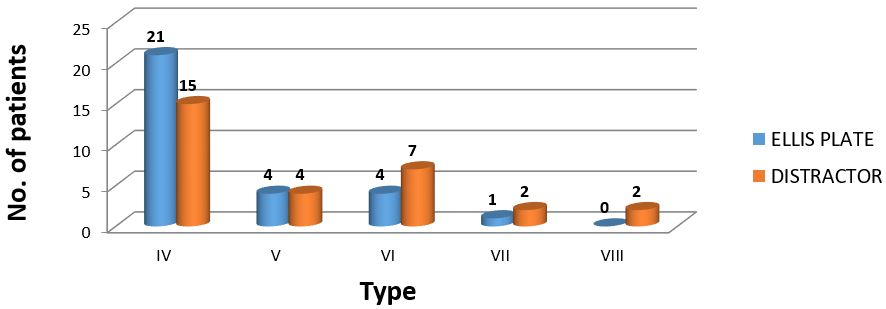A comparative study of outcome of distal radius fracture frykman type (IV-VIII) treated with distractor fixation versus volar plate
Bhinde S1, Bajoria RS2*, Kaushal A3
1 S Bhinde, Department of Orthopaedics, Gajra Raja Medical College, Gwalior, Madhya Pradesh, India.
2* R S Bajoria, Professor, Department of Orthopedics, Gajra Raja Medical College, Gwalior, Madhya Pradesh, India.
3 A Kaushal, Department of Orthopedics, Gajra Raja Medical College, Gwalior, Madhya Pradesh, India.
Background: Comminuted Distal radius fracture is a common injury with a variety of operative and non-operative management options. There remains debate as to the optimal treatment for a given patient and fracture. Our aim was to compare the functional outcome of patients of distal radius fractures treated with a volar locking plate fixation or wrist spanning distractor.
Method: This prospective randomized study comprised 30 patients with displaced intra-articular (Frykman type IV-VIII) distal end radius fractures treated with distractor and 30 patients treated with volar locking plates. The patients were followed up at 2nd week,1 month,6 months and 1 year after surgery. The assessment of pain, range of motion, grip strength and activity was done at each follow-up visit and scored according to the Green and O’Brien scoring system.
Results: At the end of 1 year, in volar plate group out of 30 patients, excellent result was achieved in 04 patients (13%), good in 24 patients (80%), fair in 02 patients (7%). No poor outcome seen. In distractor fixation group, out of 30 patients, excellent result was achieved in 01 patients (3%), good in 15 patients (50%), fair in 12 patients (40%) and poor in 02 (07%) patients.
Conclusion: volar locked plating showed superiority over distractor fixation after 1 year of surgery.
Keywords: Volar locking plate, distractor, distal end radius fracture, frykman type IV
| Corresponding Author | How to Cite this Article | To Browse |
|---|---|---|
| , Professor, Department of Orthopedics, Gajra Raja Medical College, Gwalior, Madhya Pradesh, India. Email: |
Bhinde S, Bajoria RS, Kaushal A, A comparative study of outcome of distal radius fracture frykman type (IV-VIII) treated with distractor fixation versus volar plate. ojmpc. 2017;23(1):26-31. Available From https://ojmpc.com/index.php/ojmpc/article/view/46 |





